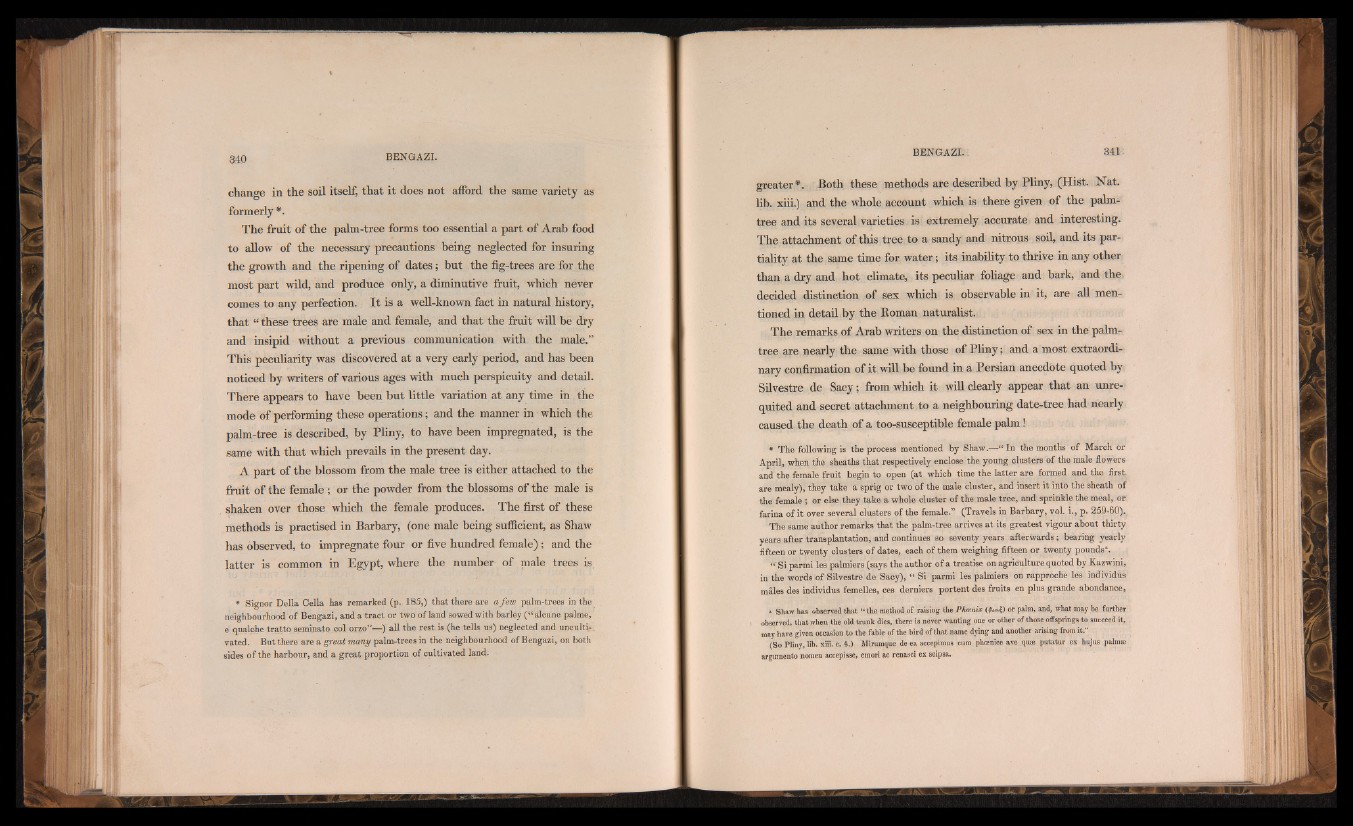
change in the soil itself, that it does not afford the same variety as
formerly*.
The fruit of the palm-tree forms too essential a part of Arab food
to allow of the necessary precautions being neglected for insuring
the growth and the ripening of dates; but the fig-trees are for the
most part wild, and produce only, a diminutive fruit, which never
comes to any perfection. I t is a well-known fact in natural history,
that “ these trees are male and female, and that the fruit will be dry
and insipid without a previous communication with the male.”
This peculiarity was discovered at a very early period, and has been
noticed by writers of various ages with much perspicuity and detail.
There appears to have been but little variation at any time in the
mode of performing these operations; and the manner in which the
palm-tree is described, by Pliny, to have been impregnated, is the
same with that which prevails in the present day.
A part of the blossom from the male tree is either attached to the
fruit of the female ; or the powder from the blossoms of the male is
shaken over those which the female produces. The first of these
methods is practised in Barbary, (one male being sufficient, as Shaw
has observed, to impregnate four or five hundred female) ; and the
latter is common in Egypt, where the number of male trees is,
* Signor Della Celia has remarked (p. 185,) that there are a few palm-trees in the
neighbourhood of Bengasi, and a tract or two of land sowed with barley (“ alcune palme,
e qualche tratto seminato col orzo”—) all the rest is (he tells us) neglected and unculti-.
vated. But there area great many palm-trees in the neighbourhood ofBengazi, on both
sides of the harbour, and a great proportion of cultivated land.
greater *. Both these methods are described by Pliny, (Hist. Nat.
lib. xiii.) and the whole, account which is there given of the palm-
tree and its several varieties is extremely accurate and interesting.
The attachment of this tree to a sandy and nitrous soil, and its partiality
at the same time for water ; its inability to thrive in any other
than a dry and hot climate, its peculiar foliage and bark, and the
decided distinction of sex which is observable in it, are all mentioned
in detail by the Koman naturalist.
The remarks of Arab writers on the distinction of sex in the palm-
tree are nearly the same with those of Pliny ; and a most extraordinary
confirmation of it will be found in a Persian anecdote quoted by
Silvestre de Sacy ; from which it will clearly appear that an unrequited
and secret attachment to a neighbouring date-tree had nearly
caused the death of a too-susceptible female palm !
* The following is the process mentioned by Shaw.—“ In the months of March ór
April, when the sheaths that respectively enclose the young clusters of the male, flowers
and the female fruit begin to open (at which time the latter are formed and the first,
are mealy), they take a sprig or two of the male cluster, and insert it into the sheath of
the female ; or else they take a whole cluster of the male tree, and sprinkle the meal, or
farina of it over several clusters of the female.” (Travels in Barbary, vol. i., p. 259-60).,
The same author remarks that the palm-tree arrives at its greatest vigour about thirty
y e a r s after transplantation, and continues so seventy years afterwards; bearing yearly
fifteen or twenty clusters of dates, each of them weighing fifteen or twenty pounds'.
“ Si parmi les palmiers (says the author of a treatise on agriculture quoted by Kazwini,
in the words of Silvestre de Sacy), “ Si parmi les palmiers on rapproche les individus
mâles des individus femelles, ces derniers portent des fruits en plus grande abondance,
* Shaw has observed that “ the method of raising the P to n w or palm, and, what may be further
observed, that when the old trunk dies, there is never wanting one or other of those offsprings to succeed it,
may have given occasion to the fable of the bird of that name dying and another arising from it.
(So Pliny, lib. xiii. c. 4.) Mirumque de ea accepimus cura phoenice ave quæ putatur ex hujus palmæ
argumento nomen accepisse, emori ac renasci ex seipsa.